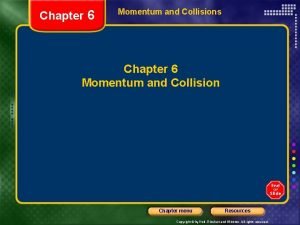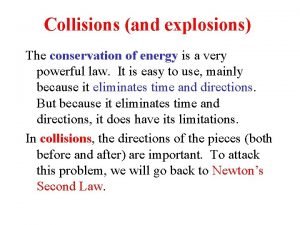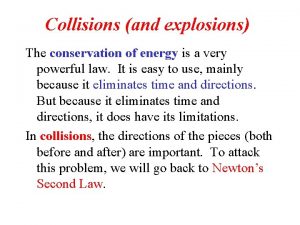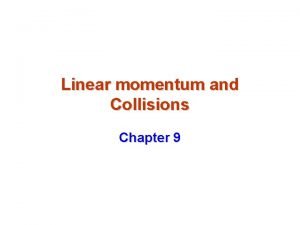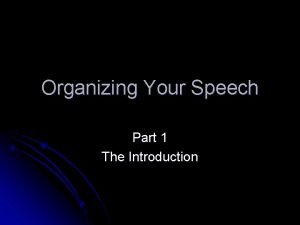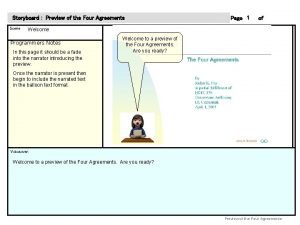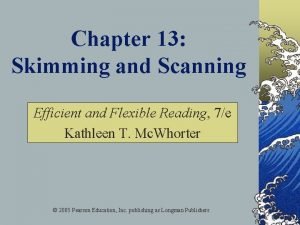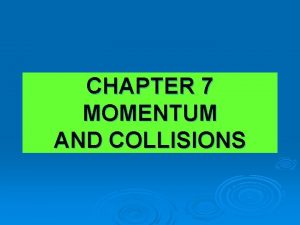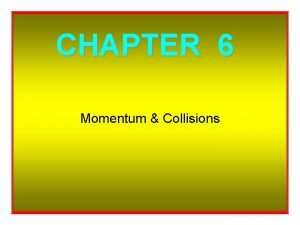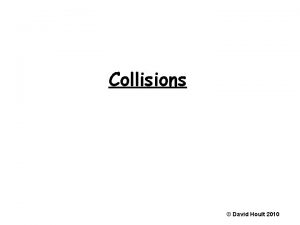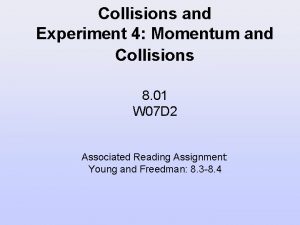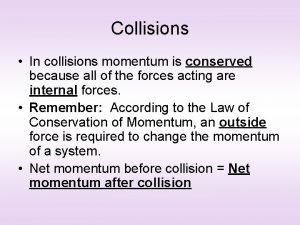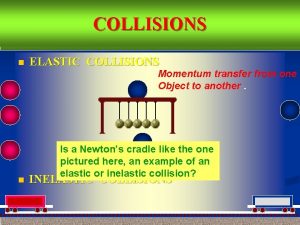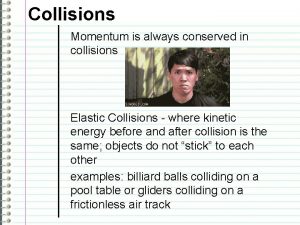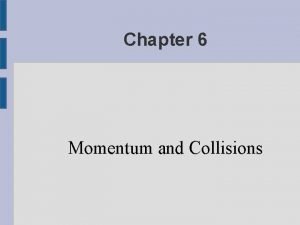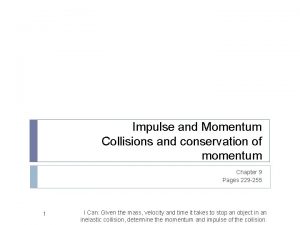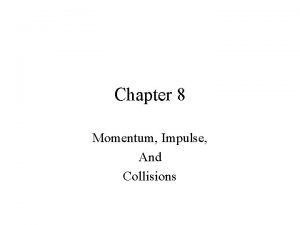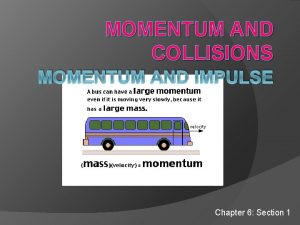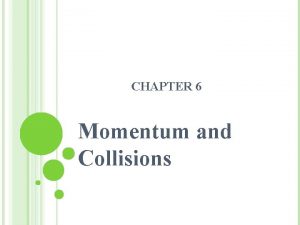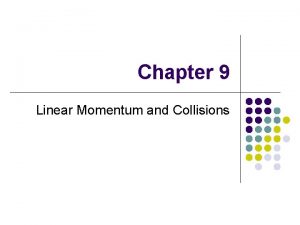Momentum and Collisions Preview Section 1 Momentum and






























- Slides: 30

Momentum and Collisions Preview Section 1 Momentum and Impulse Section 2 Conservation of Momentum Section 3 Elastic and Inelastic Collisions © Houghton Mifflin Harcourt Publishing Company Section 1

Momentum and Collisions Section 1 What do you think? • Imagine an automobile collision in which an older model car from the 1960 s collides with a car at rest while traveling at 15 mph. Now imagine the same collision with a 2007 model car. In both cases, the car and passengers are stopped abruptly. • List the features in the newer car that are designed to protect the passenger and the features designed to minimize damage to the car. • How are these features similar? © Houghton Mifflin Harcourt Publishing Company

Momentum and Collisions Section 1 What do you think? • What are some common uses of the term momentum? • Write a sentence or two using the term momentum. • Do any of the examples provided reference the velocity of an object? • Do any of the examples reference the mass of an object? © Houghton Mifflin Harcourt Publishing Company

Momentum and Collisions Section 1 Momentum • Momentum (p) is proportional to both mass and velocity. • A vector quantity • SI Units: kg • m/s © Houghton Mifflin Harcourt Publishing Company

Momentum and Collisions Section 1 Momentum and Newton’s 2 nd Law • Prove that the two equations shown below are equivalent. F = ma and F = p/ t • Newton actually wrote his 2 nd Law as F = p/ t. – Force depends on how rapidly the momentum changes. © Houghton Mifflin Harcourt Publishing Company

Momentum and Collisions Section 1 Impulse and Momentum • The quantity F t is called impulse. – SI units: N • m or kg • m/s • Impulse equals change in momentum. – Another version of Newton’s 2 nd Law – Changes in momentum depend on both the force and the amount of time over which the force is applied. © Houghton Mifflin Harcourt Publishing Company

Momentum and Collisions Impulse-Momentum Theorem Click below to watch the Visual Concept © Houghton Mifflin Harcourt Publishing Company Section 1

Momentum and Collisions Changing momentum • Greater changes in momentum( p) require more force (F) or more time ( t). • A loaded truck requires more time to stop. – Greater p for truck with more mass – Same stopping force Section 1

Momentum and Collisions Section 1 Classroom Practice Problems • A 1350 kg car has a velocity of 22. 0 m/s to the north. When braking rapidly, it stops in 4. 50 s. – What was the momentum of the car before braking? – What is the magnitude of the force required to stop the car? • Answers: – 2. 97 x 104 kg • m/s to the north – 6. 60 x 103 N © Houghton Mifflin Harcourt Publishing Company

Momentum and Collisions Section 1 Stopping Time F t = p = mv • When stopping, p is the same for rapid or gradual stops. • Increasing the time ( t) decreases the force (F). – What examples demonstrate this relationship? • Air bags, padded dashboards, trampolines, etc • Decreasing the time ( t) increases the force (F). – What examples demonstrate this relationship? • Hammers and baseball bats are made of hard material to reduce the time of impact. © Houghton Mifflin Harcourt Publishing Company

Momentum and Collisions Section 1 Classroom Practice Problems • A 65 kg passenger in a car travels at a speed of 8. 0 m/s. If the passenger is stopped by an airbag in 0. 75 s, how much force is required? – Answer: 6. 9 x 102 N • If the car does not have an air bag and the passenger is instead stopped in 0. 026 s when he strikes the dashboard, by what factor does the force increase? – Answer: F = 2. 0 x 104 N so it is 29 times greater © Houghton Mifflin Harcourt Publishing Company

Momentum and Collisions Section 1 Now what do you think? • Imagine an automobile collision in which an older model car from the 1960 s collides with a car at rest while traveling at 15 mph. Now imagine the same collision with a 2007 model car. In both cases, the car and passengers are stopped abruptly. – List the features in the newer car that are designed to protect the passenger and the features designed to minimize damage to the car. – How are these features similar? © Houghton Mifflin Harcourt Publishing Company

Momentum and Collisions Section 1 Now what do you think? • How is momentum defined? • How is Newton’s 2 nd Law written using momentum? • What is impulse? • What is the relationship between impulse and momentum? © Houghton Mifflin Harcourt Publishing Company

Momentum and Collisions Section 2 What do you think? • Two skaters have equal mass and are at rest. They are pushing away from each other as shown. • Compare the forces on the two girls. • Compare their velocities after the push. • How would your answers change if the girl on the right had a greater mass than her friend? • How would your answers change if the girl on the right was moving toward her friend before they started pushing apart?

Momentum and Collisions Section 2 Momentum During Collisions • When the bumper cars collide, F 1 = -F 2 so F 1 t = -F 2 t, and therefore p 1 = - p 2. • The change in momentum for one object is equal and opposite to the change in momentum for the other object. • Total momentum is neither gained not lost during collisions.

Momentum and Collisions Section 2 Conservation of Momentum • Total momentum remains constant during collisions. • The momentum lost by one object equals the momentum gained by the other object. • Conservation of momentum simplifies problem solving.

Momentum and Collisions Conservation of Momentum Click below to watch the Visual Concept Section 2

Momentum and Collisions Section 2 Classroom Practice Problems • A 62. 0 kg astronaut on a spacewalk tosses a 0. 145 kg baseball at 26. 0 m/s out into space. With what speed does the astronaut recoil? – Step 1: Find the initial momentum of both astronaut and baseball. • Answer: zero because vi = 0 for both – Step 2: Since pi = 0, then pf, astronaut= -pf, baseball – Step 3: Substitute and solve for vf, astronaut • Answer: -0. 0608 m/s or -6. 08 cm/s • Does a pitcher recoil backward like the astronaut when throwing the ball? Explain.

Momentum and Collisions Section 2 Classroom Practice Problem • Gerard is a quarterback and Tyler is a defensive lineman. Gerard’s mass is 75. 0 kg and he is at rest. Tyler has a mass of 112 kg, and he is moving at 8. 25 m/s when he tackles Gerard by holding on while they fly through the air. With what speed will the two players move together after the collision? • Answer: 4. 94 m/s

Momentum and Collisions Section 2 Now what do you think? • Two skaters have equal mass and are at rest. They are pushing away from each other as shown. • Compare the forces on the two girls. • Compare their velocities after the push. • How would your answers change if the girl on the right had a greater mass than her friend? • How would your answers change if the girl on the right was moving toward her friend before they started pushing apart?

Momentum and Collisions Section 3 What do you think? • Collisions are sometimes described as elastic or inelastic. To the right is a list of colliding objects. Rank them from most elastic to most inelastic. • What factors did you consider when ranking these collisions? 1. 2. 3. 4. 5. A baseball and a bat A baseball and a glove Two football players Two billiard balls Two balls of modeling clay 6. Two hard rubber toy balls 7. An automobile collision

Momentum and Collisions Perfectly Inelastic Collisions • Two objects collide and stick together. – Two football players – A meteorite striking the earth • Momentum is conserved. • Masses combine. Section 3

Momentum and Collisions Section 3 Classroom Practice Problems • An 2. 0 x 105 kg train car moving east at 21 m/s collides with a 4. 0 x 105 kg fully-loaded train car initially at rest. The two cars stick together. Find the velocity of the two cars after the collision. – Answer: 7. 0 m/s to the east • Now calculate the kinetic energy of the two cars before and after the collision. Was kinetic energy conserved? – Answer: KEbefore= 4. 4 x 107 J, KEafter= 1. 5 x 107 J • KE is not conserved. It is less after the collision.

Momentum and Collisions Inelastic Collisions • Kinetic energy is less after the collision. – It is converted into other forms of energy. • Internal energy - the temperature is increased. • Sound energy - the air is forced to vibrate. • Some kinetic energy may remain after the collision, or it may all be lost. Section 3

Momentum and Collisions Section 3 Elastic Collisions • Objects collide and return to their original shape. • Kinetic energy remains the same after the collision. • Perfectly elastic collisions satisfy both conservation laws shown below.

Momentum and Collisions Section 3 Elastic Collisions • Two billiard balls collide head on, as shown. Which of the following possible final velocities satisfies the law of conservation of momentum? – vf, A = 2. 0 m/s, vf, B = 2. 0 m/s – vf, A = 0 m/s, vf, B = 4. 0 m/s – vf, A = 1. 5 m/s, vf, B = 2. 5 m/s • Answer: all three m = 0. 35 kg v = 4. 0 m/s v = 0 m/s

Momentum and Collisions Section 3 Elastic Collisions • Two billiard balls collide head on, as shown. Which of the following possible final velocities satisfies the law of conservation of kinetic energy? – vf, A = 2. 0 m/s, vf, B = 2. 0 m/s – vf, A = 0 m/s, vf, B = 4. 0 m/s – vf, A = 1. 5 m/s, vf, B = 2. 5 m/s • Answer: only vf, A = 0 m/s, vf, B = 4. 0 m/s m = 0. 35 kg v = 4. 0 m/s v = 0 m/s

Momentum and Collisions Types of Collisions Click below to watch the Visual Concept Section 3

Momentum and Collisions Types of Collisions Section 3

Momentum and Collisions Section 3 Now what do you think? • To the right is a list of colliding objects. Rank them from most elastic to most inelastic. • What factors did you consider when ranking these collisions? 1. 2. 3. 4. 5. A baseball and a bat A baseball and a glove Two football players Two billiard balls Two balls of modeling clay 6. Two hard rubber toy balls 7. An automobile collision
 Type of momentum
Type of momentum Momentum and collisions review
Momentum and collisions review Elastic collision.
Elastic collision. Chapter 6 momentum and collisions
Chapter 6 momentum and collisions Is momentum conserved in all collisions
Is momentum conserved in all collisions Examples of thesis statements
Examples of thesis statements Thesis and preview statement example
Thesis and preview statement example Thesis and preview statement example
Thesis and preview statement example Classic trio' of selection techniques
Classic trio' of selection techniques Review and preview
Review and preview Realistic job preview pros and cons
Realistic job preview pros and cons What makes some collisions elastic and others inelastic
What makes some collisions elastic and others inelastic Collisions and explosions
Collisions and explosions Collisions
Collisions Collision and its types
Collision and its types Test prep preview
Test prep preview Test prep preview
Test prep preview Test prep preview
Test prep preview Test prep preview
Test prep preview Sccm technical preview
Sccm technical preview Preview statement speech example
Preview statement speech example Test prep preview
Test prep preview Nnn preview
Nnn preview The selection preview
The selection preview Chapter 21 standardized test practice answers
Chapter 21 standardized test practice answers The four agreements preview
The four agreements preview Test prep preview
Test prep preview Perintah print preview kita jalankan dari menu
Perintah print preview kita jalankan dari menu Test prep preview
Test prep preview Disadvantages of skimming in reading
Disadvantages of skimming in reading 1984 book preview
1984 book preview



